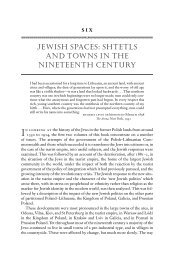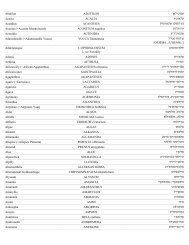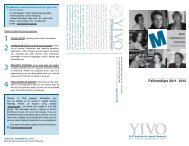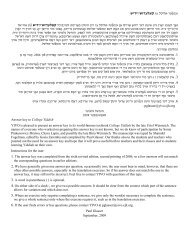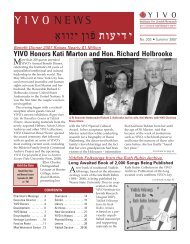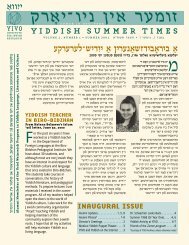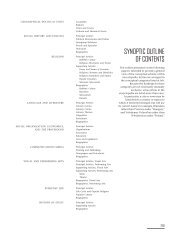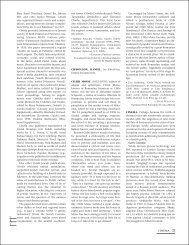t any plant names in Yiddish - YIVO Institute for Jewish Research
t any plant names in Yiddish - YIVO Institute for Jewish Research
t any plant names in Yiddish - YIVO Institute for Jewish Research
Create successful ePaper yourself
Turn your PDF publications into a flip-book with our unique Google optimized e-Paper software.
XX<br />
˘È„”È Ôȇ ËÏÚÂÂ≠ÔÒ˜ÈÂÂÚ‚ È„ Ÿ ¯ÚËÎÚ˘ È΄¯Ó<br />
Italian (<strong>for</strong> more details, see section 'East vs. West', below).<br />
b. The medieval German dialects these immigrants encountered<br />
there and later <strong>in</strong> various areas of what were to become Upper,<br />
Central, and – to a lesser degree – Lower German speech areas.<br />
c. The Hebrew-Aramaic elements that had entered the <strong>in</strong>cipient<br />
<strong>Yiddish</strong> language through various channels: as a substratum<br />
preced<strong>in</strong>g (Birnbaum 1979: 58) or contemporaneous with Zarphatic<br />
and Italkic, as an adstratum from the Hebrew and Aramaic<br />
texts of prayer and study.<br />
d. The older Central and East European stratum, consist<strong>in</strong>g of<br />
loans from coterritorial West Slavic languages: Old Czech –<br />
through the mediation of Western Canaanic (M. We<strong>in</strong>reich<br />
1973; I: 83-89; III: 12-80), <strong>for</strong> example kreyn – and Old Polish<br />
(<strong>for</strong> example, szczaw>shtshov>shtshuf>khtshuf), was the result<br />
of eastward migration and settl<strong>in</strong>g of West Slavic lands.<br />
e. As <strong>Jewish</strong> migrants moved further east, an East Slavic stratum<br />
– Ukra<strong>in</strong>ian and Byelorussian – was added. This stage had its<br />
highpo<strong>in</strong>t with the <strong>Jewish</strong> agricultural colonization <strong>in</strong> Ukra<strong>in</strong>e,<br />
Bessarabia, Byelorussia, and Crimea, where the <strong>Yiddish</strong> speech<br />
community came to know first-hand, <strong>for</strong> example, the varieties<br />
of wheat – banátke, arnaútke, khersóner gírke, etc. advertised<br />
<strong>for</strong> and by gra<strong>in</strong> dealers <strong>in</strong> the periodical Kol-mevaser <strong>in</strong> the<br />
1860s. The settlers came to know useful steppe <strong>plant</strong>s, as well<br />
as weeds. Kuráy (genus Salsola, called Russian thistle <strong>in</strong> English),<br />
<strong>for</strong> example, is mentioned countless times <strong>in</strong> <strong>Yiddish</strong> literature<br />
referr<strong>in</strong>g to <strong>Jewish</strong> colonization <strong>in</strong> Ukra<strong>in</strong>e, as well as the<br />
more recent colonization <strong>in</strong> Argent<strong>in</strong>a, <strong>in</strong> the works of such writers<br />
as B. Epshteyn, Elye Gordon, Note Lurye, Noyekh Lurye,<br />
Leyb Kvitko, and Elye Spivak (<strong>for</strong> more details, see the section<br />
on agricultural term<strong>in</strong>ology below).<br />
f. Geographically and l<strong>in</strong>guistically peripheral <strong>in</strong> the development<br />
of <strong>Yiddish</strong> botanical term<strong>in</strong>ology <strong>in</strong> Eastern Europe were the<br />
<strong>Jewish</strong> communities to the north and south of the Slavic heartland<br />
and to the south of the Carpathian mounta<strong>in</strong>s. Plant <strong>names</strong><br />
of Estonian, Hungarian, Latvian, Lithuanian, Rumanian, and Slovak<br />
provenience had local currency but failed to ga<strong>in</strong> literary acceptance,<br />
with the partial exception of the Moldavian dialect of<br />
the Rumanian language <strong>in</strong> Bessarabia.<br />
g. Difficult to place chronologically but clearly Eastern European<br />
are the various <strong>in</strong>ternal <strong>Yiddish</strong> developments – new, anonymous<br />
co<strong>in</strong>ages, semantic shifts – mentioned above.<br />
h. The next stratum – like the preced<strong>in</strong>g one – was not the result of<br />
contact with coterritorial languages, but the consciously sought<br />
<strong>in</strong>fluence of a non-contiguous language: the Germaniz<strong>in</strong>g attempts



